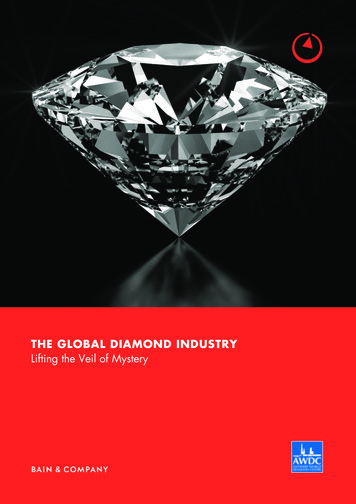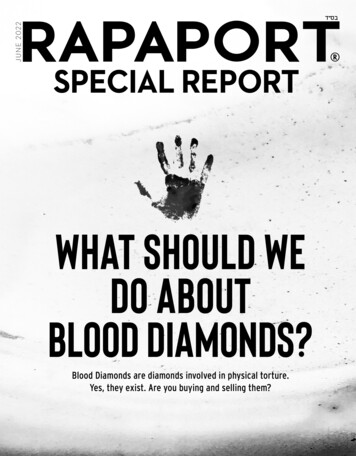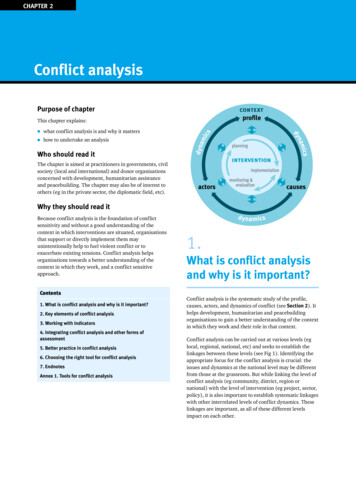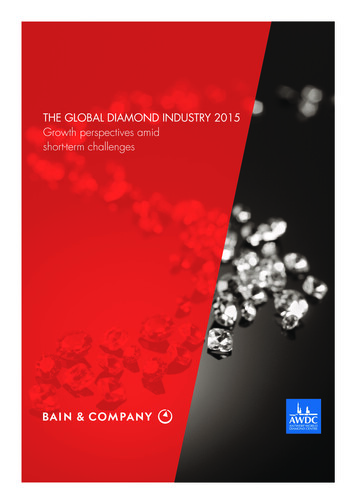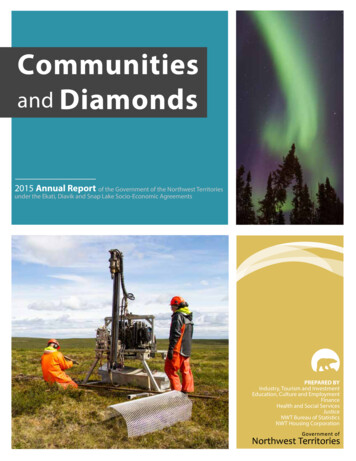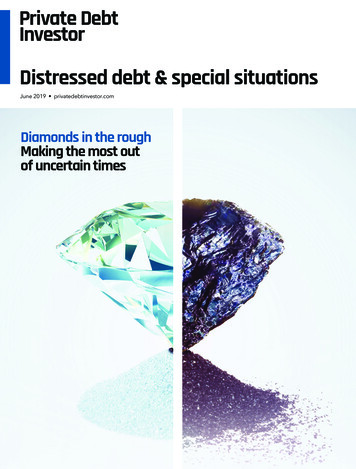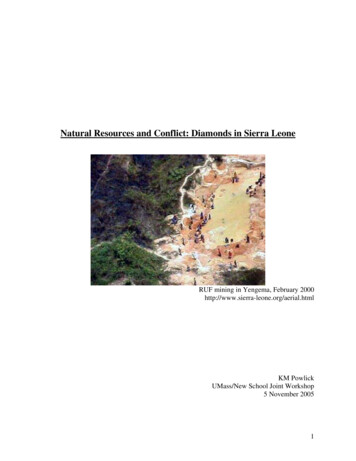
Transcription
Natural Resources and Conflict: Diamonds in Sierra LeoneRUF mining in Yengema, February 2000http://www.sierra-leone.org/aerial.htmlKM PowlickUMass/New School Joint Workshop5 November 20051
IntroductionSierra Leone is a small country encompassing approximately 72,000 square kilometers ofmountainous, tropical terrain, about 7% of which is arable. The country, nestled in the WestAfrican coast, has a large share of lush forests, with some of the wettest rainforests in WestAfrica. The coastal, capital city of Freetown (population approximately 1 million), is surroundedon the three land-facing sides by green mountains. These mountains are featured in the country’spost-independence flag – the blue stripe at the bottom representing the sea, the green stripe at thetop representing the mountains. The white stripe in the middle is to represent the peoplecelebrating independence in the streets of Freetown in 1961, waving white flags.In addition to lush foliage, white beaches, lions, and more than 6 million Sierra Leoneans,the country, often described as the ‘poorest country in the world,’ is also home to deposits ofdiamonds, titanium ore, bauxite, iron ore, gold, and chromite. If large endowments of naturalresources can be a ‘blessing’ or a ‘curse,’ these resources, especially the alluvial diamonddeposits, have been a curse for Sierra Leone as they are for many other countries that have foundthemselves embroiled in wars over abundant resources.Raw materials, such as coal in England during the early stages of the IndustrialRevolution, are necessary to the process of industrial development. Under a different set ofeconomic and political institutions, oil in Nigeria and tantalum in the Democratic Republic of theCongo (DRC)1 might have made those countries extremely rich, controlling the export of raw1Natural resources, including tantalum and coltan, played a role in the Ktanga Secession War in the DemocraticRepublic of the Congo (Ndikumana and Kisangani 2003, pp 4-9 and 9-12; Kisangani 2000; Cuvelier andRaeymaekers 2002). Likewise, oil and multinational corporations are implicated in violent conflict in Nigeria(Human Rigthts Watch 1999; Hoffman 1995). As of 1994, when the country was not in the middle of a full civilwar but was perceived by some to be on the brink, “ The Clinton administration [was] mindful of Nigeria’simportance and its economic relationship with the United States. Nigeria has been a consistently reliable supplier ofpetroleum, choosing not to participate in the Arab oil boycott of the 1970s. Recently, Nigeria has been anywherefrom America’s fifth- to it’s second-largest foreign source of crude oil. Overall U.S. investment in Nigeria2
materials necessary for production all over the world. In the absence of an artificially reducedsupply and marketing-induced demand at the hands of the giant conglomerate DeBeers, thediamonds in Sierra Leone might not be worth anything other than for their industrialapplications. Rather, an ongoing process of extraction has made these resources decidedly‘lootable,’ both a physical and social characteristic. Because of their physical characteristic,diamonds can easily be looted and carried out of a country, especially alluvial diamonds found indiffuse riverbeds as opposed to kimberlite diamonds found in concentrated mines.Thelootability of minerals and gems, however, is also due to the social relationships surroundingthese resources, consistently being looted since they were first discovered to be useful andprofitable:Since the beginning of colonialism, Asia, Africa, and the Americas were seen bythe colonizers as a source of natural wealth to be exploited for short-term gains.Although the European explorers who sailed to the Americas in search of ElDorado never found the legendary ‘City of Gold,’ they did find in the Americasand elsewhere tremendous mineral wealth and lands to produce export cropsincluding cotton, sugar, tea, coffee, and later, fruit. Five centuries later, mineralextraction and agribusiness continue to play important roles in North-South trade,with grave environmental consequences (Harper and Rajan 2004, 4).When resources are lootable, they can be fought over.Natural resources play a complex role in many conflicts, both as a reason to fight and as afactor that facilitates the conflict by providing revenues used to purchase arms and provisionarmies.Even if grievance factors are insignificant in statistical models predicting war,‘grievances’ over the governance of natural resources can play a large role in creating theopportunity for conflict.Furthermore, non-combatants in a country initiating post-conflictapproaches 4 billion, principally in the petroleum sector. By the end of the decade [1990s], Nigeria could becomean important supplier of natural gas for the United States, where demand is rising. Given the depth and growthpotential of American investment in Nigeria’s energy sector, the United States is reluctant to pursue policies thatcould undermine its commercial and energy interests there” (Hoffman 149).3
development policies may as well have grievances over natural resource management - just asnatural resources play an important role in conflict, they must play an equally important role inpost-conflict development policy. According to the World Bank program on conflict, one of themost important policies for preventing future war in a post-conflict country is the diversificationof GDP away from dependence on primary commodities. This ‘diversification,’ however, is nota simple task. Moreover, even if Sierra Leone were able to reduce its dependence on revenuesfrom sales of rough diamonds and increase incomes, also increasing the ‘opportunity cost’ ofconflict for its population, the alluvial diamond fields would still cover much of the Easternprovince of the country. Without changes in the institutions surrounding these natural resources,they remain a physically and socially lootable resource available for attempted capture byanother rebel movement.A post-conflict development plan for a country with large deposits of natural resourcesmust include not only movement away from the use of natural resources to sustain the economybut also measures to improve the governance of the natural resource, possibly with afundamental redefinition of the property rights involved. In Sierra Leone, the property rightsregime over diamonds was weak enough that rebels from the Revolutionary United Front (RUF)were able to seize control of the diamond producing region almost immediately after the groups’inception as a violent movement. These already inadequate property rights were thoroughlydisrupted over the course of the decade-long war, with the RUF, the government-backed andlater rebellious military, and South African Executive Outcomes mercenaries instituting newproperty rights at the point of a gun (or an RPG). While there are many constraints on thegovernment of Sierra Leone (GoSL) in the use of its natural resources – resulting, for example,from the practice of mortgaging rights to diamond mining to pay for the war – there is a post-4
conflict opportunity to take a critical look at the governance of natural resources and includeinnovative approaches to their use in plans to improve income generation, social and economicdevelopment, and participation in the international economic system.The purpose of this paper is to analyze the role of diamonds in the conflict in SierraLeone, and to begin the exploration what a ‘natural assets’ approach2 to post-conflictdevelopment could look like in the country. To do so, I first present an economic history of theconflict in Sierra Leone that focuses on the role of diamonds and other natural resources ininitiating, perpetuating, and ending the conflict. This will segue into the post-conflict challengesand opportunities faced by Sierra Leone, as well as a discussion of relevant policyrecommendations made by economists. I will then present a brief discussion of the NaturalAssets Project and how it could be applied to post-conflict development in Sierra Leone.Diamonds and Conflict in Sierra LeoneDiamondsSince their initial discovery in Sierra Leone in 1932, the country has exported more than32 million carats of diamonds. Until the middle of the civil war, the country also exported otherminerals such as rutile, which were mined largely by multinational corporations – a market thegovernment has worked steadily to make functional once again now that the war has ended, withrutile mines, for example, reopening in spring of 2005. The pre-conflict diamond mining industrywas characterized by a combination of corporate mining companies along with the “AlluvialDiamond Mining Scheme,” which granted licenses to small diamond producers using relativelylabor-intensive mining techniques, including skin diving to retrieve diamonds at the bottom of2See the homepage of the Natural Assets Project of the Political Economy Research Institute, including a body ofresearch relating to the project. www.umass.edu/peri5
river beds. The ‘scheme’ involved, pre-conflict approximately 30,000 Sierra Leonean as smallscale miners. The corporate structure of the diamonds industry is dominated by Sierra LeoneSelection Trust (SLST), described as a child company of DeBeers, and the National DiamondMining Company3. It has been argued that the Alluvial Diamond Mining Scheme, because thediamonds mined in this way are eventually sold through chains of dealers to one of the corporatemining firms for export, served two purposes in the diamond market – to appease traditionalrulers in the Eastern province and to obtain diamonds through labor-intensive, non-capitalist laorthat could not be obtained profitably by the larger corporations (Zack-Williams 1995, 206).Because the diamonds in Sierra Leone are alluvial, and dispersed in the ground and inriverbeds rather than in large, concentrated deposits, they can effectively be dug using minimaltechnology. The methods used for this type of mining basically involve sifting through gravel –gravel from river banks, from river beds, and from small pits – and an individual miner canunearth several carats a day worth of rough diamonds. Government licenses, which last for sixmonths and cover 400 square feet of land are beyond the reach of the average Sierra Leonean,with per capita income in the country equaling only 198. The Sierra Leonean government hasbeen accused of giving out these licenses as favors, and the remainder are mostly owned bybrokers – called ‘supportors’ – who employ ‘tributors’ in non-wage labor. Tributors are oftenpaid a fraction of the diamonds they unearth (typically 2/3), leading to a perverse incentive tounearth only the higher quality diamonds and leave diamonds of poorer quality in the ground.The majority of Sierra Leoneans involved in diamond mining have no share of‘ownership’ over the diamonds they are working with, and have many valid grievances againstthe clientalist state. These include both that licenses to mine diamonds are too frequently handed3Post-conflict, this sector of the diamond industry is likely to expand, both from new interests looking to becomeinvolved in Sierra Leonean diamond mining and because the government of Sierra Leone mortgaged the diamondresources to Executive Outcomes to help pay for the conflict.6
out as favors and that the direct producers receive few of the benefits to diamond mining, withthe profits going mainly to middle-men and large corporations. Most Sierra Leoneans have noincentive to protect the diamonds on their own4. Dispersed as the diamonds are over a largeterritory, this lack of community governance, combined with a limited capacity of the GoSL todirectly protect them, helped to make the diamonds socially lootable, and to become the object ofwar.Origins of ConflictDiamonds are implicated in the conflict in Sierra Leone from its very inception. CharlesTaylor, the former President of Liberia, is often cited as having started the conflict in SierraLeone through his direct sponsorship of diamond bandits who then smuggled the gems throughthe Sierra Leonean border with Liberia. For example, Stephen Burgess, in an article on regionalpeacekeeping in Africa states: “The failure of the United States to respond to pleas from itstraditional Liberian ally during the disintegration of the dictatorship of Samuel Doe in 1990permitted a rebel incursion to escalate into a protracted conflict; subsequently, it spilled over intoSierra Leone, a similarly weak state” (Burgess 1998, 41).This version of the origins of the conflict, however, can be debated, as the RUF and latertwo military juntas, the National Provisional Ruling Council and the Armed ForcesRevolutionary Council, all shared a similar ideological stance – against the corrupt, clientalist,4However, large multinational corporations involved in the extraction of diamonds and other mineral resources dohave incentives to protect their own diamond territory – and have, using private military forces (Reno 1997a, 504).The same firms have faced problems when they contracted instead with the RSLMF for protection. For example,military commanders charged in 1995 with protecting the US-Australian rutile company, Sierra Rutile, and a Swissbauxite company, SIEROMOCO – with these two firms together making up 57% of 1994 export earnings –allegedly colluded with rebels who kidnapped foreigners working for the firms, leading them to exit the country(Reno 1997, 180),7
single party regime of the All People’s Congress (APC). It has been argued that these threerebellious movements, all comprised largely of young people in their twenties at most (althoughSankoh, the leader of the RUF, was much older), were the product of a post-colonial politicalculture bereft of a formally articulated radical alternative to single party rule (Abdullah 1998).Even if the political conflict in Sierra Leone has its own, independent origins, the violentconflict is heavily linked to Taylor’s regime and the ability to finance conflict through smugglingdiamonds through Liberia. Examining at the circle of influence outside of West Africa, Taylorhas been linked financially to many international allies including Al Quaeda and Americantelevangelist Pat Robertson5. In addition to sanctions on the country of Liberia, the UnitedNations indicted Charles Taylor for war crimes because of his involvement in the Sierra Leoneanconflict. In 2003, he was also indicted on seventeen counts of crimes against humanity and otherviolations by the Special Court in Sierra Leone. Taylor was given safe haven in Nigeria inAugust 2004 as the Liberian capital of Monrovia was threatened by rebels and as of January2005 he had not been turned over to the court to face trial.Beyond the neighboring country of Liberia, there is still a broader international link in thebeginnings of the Sierra Leonean conflict. The monopolistic control of diamonds has dated fromthe discovery of diamonds in Southern Africa in the late nineteenth century and has beeninstrumental in the social construction of the diamond as something worth fighting over6. DeBeers is able to maintain high diamond prices by buying up control over the world’s diamondsupplies and managing the amount available for sale, also enabling the corporation to weather5Taylor has also been linked to Libya, as a ‘surrogate’ of Qaddafi, as well as to Al-Qaeda through the diamond trade(Burlij, c. 2005; Noble 1998; Bender, 2004; Gelfand 2004). It is interesting that Charles Taylor has also been linkedto powerful individual Americans – such as to televangelist Pat Robinson in two mineral extraction ventures in 1994and 1999 (King 2001). Taylor and his National Patriotic Front was also supported at the time of his first attemptedcoup by the president of Cote D’Ivoire, France’s “principal ally in Africa” (Burgess 1998, 53).6A short discussion of the ‘invention’ of the diamond can be found in (Stanton 2002).8
dips in the price of finished diamonds (Ariovich 1985). This, coupled with the conditioningmodern advertising companies levy towards young women and men (“a diamond is forever” andthe idea that a diamond is the only acceptable stone for an engagement ring) leads them to covetdiamonds as symbols of wealth and status while at the same time conditioning not to resell,increasing the price even more7. As a result, the price of finished diamonds is astronomicallyhigher than the price of rough diamonds coming out of countries like Sierra Leone – in 1981, forexample, the value of the market for finished diamonds was 9 times that of rough diamonds.Even though the majority of diamonds sold in the international market are industrial diamonds,the majority of the wealth changing hands is due to the sale of jewelry diamonds, most of thesebought for women’s engagement rings in North America and Europe, and very high quality‘investment’ diamonds.Diamonds in jewelry sector constitute over 2/3 of total rough diamond sales. Thismeans that jewelry demand accounts for the lion’s share of total diamond salesand the fortunes of diamond producers, and suppliers in the long term, areconsiderably dependent on the jewelry sector. Because of the large markups ondiamonds along distribution channels, the value of retail sales of polisheddiamonds can increase to many times the value of stones in its rough form. Forinstance, retail value of diamond sales in 1981 totaled 18.0 billion, while thevalue of rough diamonds sold was probably only around 2.0 billion (Ariovich235).Moreover, the majority (more than 90%) of industrial grade diamonds are at this pointsynthetic, meaning that the market for Sierra Leonean rough diamonds would collapse withoutthe advertisement-driven demand and monopolistically controlled supply for finished jewelryand investment diamonds. While the war was not started by De Beers instructing Charles Taylorto smuggle diamonds through his country, the so-called invention of the diamond wasinstrumental in making diamonds a lootable resource in the first place. Diamonds only possess7The Atlantic Monthly published a series of articles on the diamond market in the early 1980’s that discuss theparadox of such high demand for diamonds but the difficulties of resale (Epstein 1982; Epstein 1982a, Epstein1982b).9
such high ‘value’ through the international economic system, implicating the system itself inconflicts fought over diamonds such as in Sierra Leone.Chronology of ConflictAs a bona fide civil war, the conflict started in 1990-1991 when Foday Sankoh, acharismatic former military corporal, hijacked an unorganized movement of young boys whowere gathering in Freetown after the institution of fees for government schools8. From thisinitial group of boys, Sankoh built an army largely made of children, with both boys and girlsbeing used as fighters. Girls were also used for sexual and domestic labor9. The “recruitment”methods of the RUF included threatening children and teenagers that if they did not join therebels their family would be murdered in front of them, often following rape and torture. TheRUF has been accused of forcing these children to be injected with cocaine as well as to eatgunpowder as part of ongoing indoctrination rituals10. Once children were indoctrinated into theRUF, they were often forced to lead raids against their own villages as tests of their loyalty. The8This account is synthesizing several accounts of the civil war in Sierra Leone, each of which presents the storyfrom a different perspective (Abdullah 1998; Gershoni, 1997; Murphy 2003; Peters and Richards 1998; Richards1996; UNAMSIL 2005). A brief chronology of the conflict in Sierra Leone up through the Lome Accords can befound at www.cryfreetown.org, the companion site of the documentary Cry Freetown by Sierra Leonean filmmakerSorious Samura.9Child armies are one of the great shames of the twentieth and twenty-first century – the Coalition to end the use ofChild Soldiers reports that, in 1998, there were as many as 300,000 children being used as soldiers around the world.See www.child-soldiers.org. The Coalition also published reports on the use of child soldiers in Sierra Leone in2004 (Coalition to Stop the Use of Child Soldiers 2005, 2005a). Physicians for Human Rights (2005) published anextensive report on the use of sexual violence in Sierra Leone.10Several papers and books describe the ‘recruitment’ methods, use of children, use of rape, and use of drugs by theRUF as well as the RSLMF. These articles include interviews with former child soldiers from both the RUF and theRSLMF, who are surprisingly articulate about why they fought and why they believed the children who were theirenemies in conflict fought (Abdullah 1998; Peters and Richards 1998; Richards 1996). A former RUF child soldierinterviewed in Peters and Richards (205) denied the use of drugs in their RUF camp, while a former child soldierfrom the RSLMF recounted a litany of drugs used by him and other soldiers (195). Human Rights groups haveaccused both sides of using drugs, and this child’s testimony cannot discount these accusations. Girls, includingthose directly involved in the fighting, reported being routinely raped by both RUF rebels and RSLMF soldiers,describing RSLMF soldiers only as less brutal (191, 192).10
RUF swept through the country, killing, raping, and amputating limbs from non-combatants.Aside from destroying villages with the kind of gusto only traumatized children on cocaine couldmanage, the RUF also worked steadily to control the diamond producing regions in the Easternprovinces. They succeeded within a year, turning villages and tracts of forest, such as in theKono region, into giant open-pit mines.The RUF, like many rebel groups engaged in violent conflict, presented itself as anideologically based, revolutionary opposition movement fighting against a corrupt, clientalistgovernment. The fact that so many children, along with adolescents and adults, fought for theRUF cannot solely be explained through terror tactics to keep them from running away. Theloyalty of child soldiers may rather be attributed to the fact that the adult RUF officers providedsurrogate ‘patrons’ to their ‘client’ child soldiers, replacing the very same patron-clientrelationship they claimed to be fighting (Murphy 2003). This then places the population in therole of ‘subject,’ in relation to the child soldiers – a role marked by a lack of power. A formerchild soldier who fought with the Kamajors stated that RUF child soldiers left notes behind themafter an attack, explaining their ideology about drastic changes that needed to be made within thecountry, especially in regards to access to education and other opportunities – statements withwhich this former child soldier agreed. The same former combatant then went on to state that hedid not believe the self-stated motives of the RUF were in line with their tactics – waging war onthe rural poor of the country (Peters and Richards 1998, 200-201). This is a sentiment echoed bymany intellectuals inside and outside of Sierra Leone, leading to widespread doubt about the‘revolutionary’ character of the Revolutionary United Front.11Given the importance of11At least one author, Paul Richards (1996) in Fighting for the Rainforest, however, seems to take the RUF ideologyat face value, although this is not to imply that he believed they were in the right for adopting violence as theirstrategy. Richards is critiquing a theory on African war he labels ‘new barbarism’– that Africans engage in war11
diamonds in the conflict and the devotion of large amount of RUF manpower to diamondmining, the RUF was a highly corrupt movement, perhaps better characterized as ‘rebellious’than ‘revolutionary’12The government, at this point headed by President Joseph Momoh of the APC, respondedwith its small RSLMF, tripling to 14,000 at the start of the conflict. However, this military waslargely undisciplined and has been accused of adopting similar tactics to the RUF – includingterrorizing the rural population, recruiting children, and mining diamonds for individual profitrather than fighting the rebels. The inadequacy of the military was addressed in several ways:with the formation of a locally-based ‘Kamajor’ Civil Defense Force (CDF) militia, with mostlyNigerian Military Observer Group (ECOMOG) peacekeepers deployed through the EconomicCommunity of West African States (ECOWAS), and, eventually, with the use of mercenariesfrom the South African private security company Executive Outcomes. Other internationalforces were involved in the conflict as well, including a small UN observer mission in 1998subsequent to the Lome Accords, the United Nations Mission in Sierra Leone peacekeepingforce of more than 4,000 in 1999, and British peacekeepers in 2000 after an attack on Freetown.The Kamajor militias (also called Tamaboros in the South) were developed through adecentralized network of villages in direct response to the failure of RSLMF troops to adequatelyprotect the rural diamond producing regions and were not directly under the control of the centralgovernment, directed instead by local Paramount Chiefs. A traditional feature of Sierra Leoneanculture is secret societies for both boys and girls, with initiation often marked by ritualizedscarification and including secret knowledge of herbal medicines (that can both harm and heal),‘magic’ that is sometimes used for street performance, and traditional hunting techniques. Thebecause of ancient religious and ethnic hatreds and that conflict in Africa is a throwback to some African Dark Age.Rather, he attempts to explain the war within a cultural context.12The term ‘rebellious’ is often used to refer to the RUF, the NPRC, and the AFRC in (Abdullah 1998).12
Kamajors called on this traditional knowledge of ambushing and tracking as well as traditions todraft individuals in the protection of their villages to build an anti-rebel militia made up of ruralvillagers serving tours of a few months to a year (although individual Kamajors may have servedlonger). Like the RUF and the RSLMF, the Kamajors included children in the fighting.While RSLMF troops and Kamajors might have been fighting for the same reasons –including, even for child soldiers, revenge against the RUF for murdering their loved ones(Peters and Richards 1998) - the institutional structure of the two forces were different and as awhole the two fighting bodies responded to different incentives. The RSLMF was a force madeup mostly of professional soldiers, including irregular children attachments only during the war.While they were defending their ‘motherland,’ they were also hired soldiers fighting becausethey earned a wage, which was often paid late if at all. Soldiers earning low and erratic wagesmay be tempted to add loot to their meager paychecks, especially when they are witnessing thesame thing from their enemy in close proximity, in this case spouting a rhetoric of anticlientalism many soldiers could most likely agree with. Consequently, many RSLMF soldierswith questionable loyalty became “sobels” (soldier-rebels).The RSLMF proved to be anunreliable force against the rebels and, indeed, following a pay revolt in the 1997, some factionswithin the army, along with RUF rebels, formed Armed Forces Revolutionary Council (AFRC)and aligned themselves with the RUF. While the Kamajors cannot be treated as saints and havebeen indicted for human rights abuses by the Special Court of Sierra Leone, they were not facingthe same incentives for looting that the regular army did, as they were fighting directly becauseof traditional obligations and a sense of ‘duty,’ in addition to motives of revenge and protectionof the motherland they may have shared with RSLMF soldiers. However, the Kamajor militia –along with loyal RSLMF troops – was not sufficient to defeat the RUF.13
In 1991, President Momoh requested that ECOWAS send ECOMOG peacekeepers toSierra Leone to attempt to enforce peace between the RUF and the government. Regionalorganizations such as ECOWAS in West African (dominated by Nigeria) and SADC in southernAfrica (dominated by South Africa), have shown themselves more willing to engage in ‘peaceenforcement’ than international peacekeeping forces from the United Nations or rich nationssuch as the Untied States and Britain (Burgess 1998, 39). As it did in the two ECOMOGpeacekeeping missions to date – against Charles Taylor’s initial attempts at a coup in Liberia in1990 and against the RUF in Sierra Leone – this often involves directly engaging in the fighting,meaning overtly choosing a side, unlike in supposedly impartial UN peacekeeping missions13.When the RUF failed to comply with a peace accord in Sierra Leone, the ECOMOG troopspursued them into the bush. Like the regular military – many soldiers even joining the RUFthemselves as individuals and later as a group – and the Kamajors, the ECOMOG troops wereunsuccessful at defeating the RUF rebels. ECOMOG continued operations in Sierra Leone oftenduring the remainder of the conflict, including after a successful military coup by junior officersin April 1992 that placed Captain Valentine Strasser in power14 and another subsequent coup.ECOMOG troops have been accused of human rights abuses both in Liberia and in SierraLeone15. For example a young Temne man, Peter, whose father was a member of the RSLMFsuspected of fighting with the rebels, related to me an encounter he had with ECOMOGpeacekeepers in 1996, just after having completed high school. He and a cousin, whose fatherwas also in the military, were abducted from their home by Nigerian ECOMOG troops and13The merits of regional vs international peacekeeping can be debated. Collier et. al (2003) discuss some of theproblems of regional peacekeeping in Breaking the Conflict Trap, such as that the missions are often led by aregional hegemon and may not be as impartial as UN peacekeeping missions (1
gravel from river banks, from river beds, and from small pits - and an individual miner can unearth several carats a day worth of rough diamonds. Government licenses, which last for six months and cover 400 square feet of land are beyond the reach of the average Sierra Leonean, with per capita income in the country equaling only 198.


